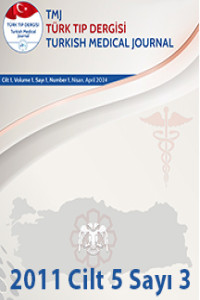Abstract
Giriş: Klavikula kırığı doğum travmaları arasında en sık görülen kemik kırığı olup genellikle tek taraflıdır. Her iki klavikula kırığı ise nadir görülen bir durumdur. Omuz distosisi veya
mokrozomik yenidoğanın makat prezentasyonu sonucu geliştiği düşünülür. Ancak son zamanlarda yapılan çalışmalarda görülmüştür ki; yenidoğan klavikula kırıklarının çoğunluğu
normal yenidoğanda ve normal doğum sonrası gelişmektedir. Günümüzde tek taraflı klavikula kırığı normal doğumun tahmin edilemeyen ve kaçınılamayan sık bir komplikasyonu
olarak görülmektedir.
Vaka sunumu: Çalışmamızda doğumsal brakiyal pleksus felci olmadan her iki klavikula kırığı görülen term bir yenidoğan vakası sunduk. Her iki taraf moro refleksi yoktu fakat her iki
taraf yakalama refleksi normaldi. Palpasyonla her iki klavikula üzerinde krepitasyon alınıyordu. Her iki kol aktif hareketleri sınırlı iken, pasif hareketlerinde de bebek ağlamaktaydı. X-ray
ile her iki klavikulada kırık saptandı. Her iki klavikula kırığı herhangi bir sekel bırakmadan dört haftada iyileşti.
Çıkarım: Moro refleksi olmayan veya brakiyal pleksus felci olan her yenidoğanda klavikula kırığı gözönünde bulundurulmalıdır.
ABSTRACT
Introduction: The fracture of clavicle is the most frequently observed bone fracture as birth trauma and it is usually unilateral. Bilateral clavicular fractures are very rare. It was stated
that it is usually observed following shoulder dystocia deliveries or breech presentation of macrosomic newborns. However later report shows that the majority of clavicular fractures
occur in normal newborns during normal labor and delivery. Later report shows that clavicle fracture is generally considered as an unpredictable and unavoidable complication of normal
birth.
Case Presentation: We report a term newborn with bilateral clavicle fracture without brachial plexus palsy due to birth trauma. Bilateral moro reflex was absent whereas grasping reflex
was normal. There was crepitation on both clavicula with palpation. Patient has cried with passive motion of both arms and active motion was limited. Chest X-rays confirmed bilateral
fracture of clavicles. Patient recovered without any sequel, approximately after four weeks.
Conclusion: Clavicular fracture should be considered in any neonate with absent Mororeflex or with bracial plexus palsy.
Keywords
References
- 1. http://orthoinfo.aaos.org/topic.cfm?topic=A00072 (Erişim tarihi: 12Mart 2013).
- 2. Kanik A, Sutcuoglu S, Aydinlioglu H, Erdemir A, Arun Ozer E. Bilateral clavicle fracture in two newborn infants.Iran J Pediatr. 2011; 21(4):553-5.
- 3. Suderland AG, Knight DJ. Bilateral fractured clavicles-a pair of cases. Acta Orthop Belg 2000;66: 306-7.
- 4. HET van den Bout, CH Snyckers. Bilateral clavicle fractures: A case report and review of the literatüre. Orthopaedic Journal Winter 2011;10(2):56-66.
- 5. Peleg D, Hasnin J, Shalev E. Fractured clavicle an Erb’s palsy unrelated to birth trauma. Am J Obstet Gynecol
- 1997;177(5):1038-40. 6. Kaplan B, Rabinerson D, Avrech OM,Carmi N, Steinberg DM, Merlob P. Fracture of the clavicle in the newborn following normal labor and delivery. Int J GynaecolObstet. 1998;63(1):15-20.
- 7. Joseph PR, Rosenfeld W. Clavicularfractures in neonates. Am J Dis Child 1990;144(2):165-7.
- 8. Narchi H, Kulaylat NA, Ekuma-Nkama E. Clavicle fracture and brachial plexus palsy in the newborn: Risk factors and outcome. Ann Saudi Med. 1996;16(6):707-10.
- 9. Herring JA. Upper extremity fractures. In: Tachdjian’s Pediatric Orthopaedics. 3rd ed. Philadelphia; Saunders: 2002:2115-250.
- 10. Walle T, Hartikainen-Sorri AL. Obstetric shoulder injury. Associated risk factors, prediction and prognosis. Acta Obstet Gynecol Scand. 1993;72(6):450-4.
- 11. Baskett TF, Allen AC. Perinatal implications of shoulder dystocia. Obstet Gynecol. 1995;86(1):14-7.
- 12. Levine MG, Holroyde J, Woods JR Jr, Siddiqi TA, Scott M, Miodovnik M. Birth trauma: incidence and predisposing factors. Obstet Gynecol. 1984;63(6):792-5.
- 13. Lurie S, Wand S, Golan A, Sadan O. Risk factors for fractured clavicle in the newborn. J Obstet Gynaecol Res. 2011;37(11):1572-4.
Abstract
References
- 1. http://orthoinfo.aaos.org/topic.cfm?topic=A00072 (Erişim tarihi: 12Mart 2013).
- 2. Kanik A, Sutcuoglu S, Aydinlioglu H, Erdemir A, Arun Ozer E. Bilateral clavicle fracture in two newborn infants.Iran J Pediatr. 2011; 21(4):553-5.
- 3. Suderland AG, Knight DJ. Bilateral fractured clavicles-a pair of cases. Acta Orthop Belg 2000;66: 306-7.
- 4. HET van den Bout, CH Snyckers. Bilateral clavicle fractures: A case report and review of the literatüre. Orthopaedic Journal Winter 2011;10(2):56-66.
- 5. Peleg D, Hasnin J, Shalev E. Fractured clavicle an Erb’s palsy unrelated to birth trauma. Am J Obstet Gynecol
- 1997;177(5):1038-40. 6. Kaplan B, Rabinerson D, Avrech OM,Carmi N, Steinberg DM, Merlob P. Fracture of the clavicle in the newborn following normal labor and delivery. Int J GynaecolObstet. 1998;63(1):15-20.
- 7. Joseph PR, Rosenfeld W. Clavicularfractures in neonates. Am J Dis Child 1990;144(2):165-7.
- 8. Narchi H, Kulaylat NA, Ekuma-Nkama E. Clavicle fracture and brachial plexus palsy in the newborn: Risk factors and outcome. Ann Saudi Med. 1996;16(6):707-10.
- 9. Herring JA. Upper extremity fractures. In: Tachdjian’s Pediatric Orthopaedics. 3rd ed. Philadelphia; Saunders: 2002:2115-250.
- 10. Walle T, Hartikainen-Sorri AL. Obstetric shoulder injury. Associated risk factors, prediction and prognosis. Acta Obstet Gynecol Scand. 1993;72(6):450-4.
- 11. Baskett TF, Allen AC. Perinatal implications of shoulder dystocia. Obstet Gynecol. 1995;86(1):14-7.
- 12. Levine MG, Holroyde J, Woods JR Jr, Siddiqi TA, Scott M, Miodovnik M. Birth trauma: incidence and predisposing factors. Obstet Gynecol. 1984;63(6):792-5.
- 13. Lurie S, Wand S, Golan A, Sadan O. Risk factors for fractured clavicle in the newborn. J Obstet Gynaecol Res. 2011;37(11):1572-4.
Details
| Primary Language | Turkish |
|---|---|
| Subjects | Orthopaedics |
| Journal Section | Case Reports |
| Authors | |
| Publication Date | December 26, 2011 |
| Published in Issue | Year 2011 Volume: 5 Issue: 3 |



